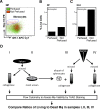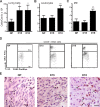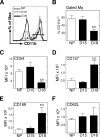Residency and activation of myeloid cells during remodeling of the prepartum murine cervix
- PMID: 22914314
- PMCID: PMC3509777
- DOI: 10.1095/biolreprod.112.101840
Residency and activation of myeloid cells during remodeling of the prepartum murine cervix
Abstract
Remodeling of the cervix is a critical early component of parturition and resembles an inflammatory process. Infiltration and activation of myeloid immune cells along with production of proinflammatory mediators and proteolytic enzymes are hypothesized to regulate cervical remodeling as pregnancy nears term. The present study standardized an approach to assess resident populations of immune cells and phenotypic markers of functional activities related to the mechanism of extracellular matrix degradation in the cervix in preparation for birth. Analysis of cells from the dispersed cervix of mice that were nonpregnant or pregnant (Days 15 and 18 postbreeding) by multicolor flow cytometry indicated increased total cell numbers with pregnancy as well as increased numbers of macrophages, the predominant myeloid cell, by Day 18, the day before birth. The number of activated macrophages involved in matrix metalloproteinase induction (CD147) and signaling for matrix adhesion (CD169) significantly increased by the day before birth. Expression of the adhesion markers CD54 and CD11b by macrophages decreased in the cervix by Day 18 versus that on Day 15 or in nonpregnant mice. The census of cells that expressed the migration marker CD62L was unaffected by pregnancy. The data suggest that remodeling of the cervix at term in mice is associated with recruitment and selective activation of macrophages that promote extracellular matrix degradation. Indices of immigration and activities by macrophages may thus serve as markers for local immune cell activity that is critical for ripening of the cervix in the final common mechanism for parturition at term.
Figures




Comment in
-
The recruitment and activation of leukocytes into the immune cervix: further support that cervical remodeling involves an immune and inflammatory mechanism.Biol Reprod. 2012 Nov 1;87(5):107. doi: 10.1095/biolreprod.112.105049. Print 2012 Nov. Biol Reprod. 2012. PMID: 23018183 No abstract available.
Similar articles
-
The recruitment and activation of leukocytes into the immune cervix: further support that cervical remodeling involves an immune and inflammatory mechanism.Biol Reprod. 2012 Nov 1;87(5):107. doi: 10.1095/biolreprod.112.105049. Print 2012 Nov. Biol Reprod. 2012. PMID: 23018183 No abstract available.
-
Parturition and recruitment of macrophages in cervix of mice lacking the prostaglandin F receptor.Biol Reprod. 2008 Mar;78(3):438-44. doi: 10.1095/biolreprod.107.063404. Epub 2007 Nov 14. Biol Reprod. 2008. PMID: 18003949 Free PMC article.
-
Transection of the pelvic or vagus nerve forestalls ripening of the cervix and delays birth in rats.Biol Reprod. 2011 Mar;84(3):587-94. doi: 10.1095/biolreprod.110.086207. Epub 2010 Nov 24. Biol Reprod. 2011. PMID: 21106964 Free PMC article.
-
The role of leukocyte traffic and activation in parturition.J Soc Gynecol Investig. 2003 Sep;10(6):323-38. doi: 10.1016/s1071-5576(03)00116-3. J Soc Gynecol Investig. 2003. PMID: 12969775 Review.
-
Immunobiology of Cervix Ripening.Front Immunol. 2020 Jan 24;10:3156. doi: 10.3389/fimmu.2019.03156. eCollection 2019. Front Immunol. 2020. PMID: 32038651 Free PMC article. Review.
Cited by
-
Loss of progesterone receptor-mediated actions induce preterm cellular and structural remodeling of the cervix and premature birth.PLoS One. 2013 Dec 10;8(12):e81340. doi: 10.1371/journal.pone.0081340. eCollection 2013. PLoS One. 2013. PMID: 24339918 Free PMC article.
-
Cell-Free Fetal DNA Increases Prior to Labor at Term and in a Subset of Preterm Births.Reprod Sci. 2020 Jan;27(1):218-232. doi: 10.1007/s43032-019-00023-6. Epub 2020 Jan 1. Reprod Sci. 2020. PMID: 32046392 Free PMC article.
-
A single-cell atlas of murine reproductive tissues during preterm labor.Cell Rep. 2023 Jan 31;42(1):111846. doi: 10.1016/j.celrep.2022.111846. Epub 2023 Jan 3. Cell Rep. 2023. PMID: 36599348 Free PMC article.
-
The pathophysiology of human premature cervical remodeling resulting in spontaneous preterm birth: Where are we now?Semin Perinatol. 2017 Nov;41(7):427-437. doi: 10.1053/j.semperi.2017.07.014. Epub 2017 Aug 18. Semin Perinatol. 2017. PMID: 28826790 Free PMC article. Review.
-
Preterm Labor, a Syndrome Attributed to the Combination of External and Internal Factors.Matern Fetal Med. 2021 Dec 16;4(1):61-71. doi: 10.1097/FM9.0000000000000136. eCollection 2022 Jan. Matern Fetal Med. 2021. PMID: 40406574 Free PMC article. Review.
References
-
- Word RA, Li XH, Hnat M, Carrick K. Dynamics of cervical remodeling during pregnancy and parturition: mechanisms and current concepts. Semin Reprod Med 2007; 25: 69 79 - PubMed
-
- Golightly E, Jabbour HN, Norman JE. Endocrine immune interactions in human parturition. Mol Cell Endocrinol 2011; 335: 52 59 - PubMed
-
- Leppert PC. Anatomy and physiology of cervical ripening. Clin Obstet Gynecol 1995; 38: 267 279 - PubMed
-
- Read CP, Word RA, Ruscheinsky MA, Timmons BC, Mahendroo MS. Cervical remodeling during pregnancy and parturition: molecular characterization of the softening phase in mice. Reproduction 2007; 134: 327 340 - PubMed
-
- Hertelendy F, Zakar T. Prostaglandins and the myometrium and cervix. Prostaglandins Leukot Essent Fatty Acids 2004; 70: 207 222 - PubMed
Publication types
MeSH terms
Substances
Grants and funding
LinkOut - more resources
Full Text Sources
Medical
Research Materials

